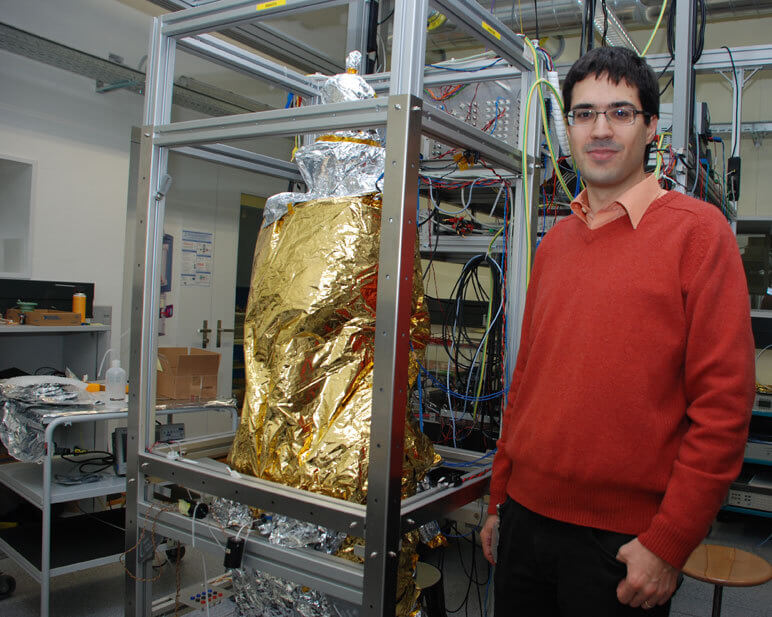How often have we promised to “make time” for something, from cleaning out the basement to hooking up with a friend we haven’t seen in a while. No matter how well-intentioned we are, it seems there are always more things we’d like/need to do than time in the day. For the scientists at the Jules Vernes-esque International Earth Rotation and Reference Systems Service, part of the Paris Observatory, this isn’t a problem. They actually have the power (periodically) to make time. While eminent philosophers and physicists continue to argue over the nature of space-time, others are working quietly in the background, making seconds which are then injected into the temporal nebula. And have been doing for the past 46 years. The origins of this wizardry lie with the invention of the atomic clock – an area in which Switzerland isn’t lacking.
A scientific discovery
Since Antiquity, time has been defined through observations of the stars. For centuries, the second was equal to 1/86,400th of a mean solar day. Hence one complete transit of the Sun (two consecutive passages through the zenith) takes 86,400 seconds. This unit of Universal Time remained in effect until the 1960s, when new instruments transformed our temporal system.
In 1967, the second was redefined as the duration of 9,192,631,770 periods of radiation from a caesium-133 atom.
The first atomic clocks of the late 1940s revolutionised the scientific world, which little by little could count on (literally) hitherto untold precision. In 1967 the second was redefined as the duration of 9,192,631,770 periods of the radiation corresponding to the transition between two hyperfine levels of the fundamental state of a cesium-133 atom. Set by convention – it could just as easily have been one more or one less period – this definition brought to light a previously unknown phenomenon.
Astronomers taught us long ago that the interval between two zeniths isn’t constant, due to the fact that the Earth’s path around the Sun isn’t circular but elliptical. Furthermore, the Earth is inclined 23° relative to the plane of its solar orbit. As a result, the length of the true solar day varies. It can be shorter by as much as 16 minutes 23 seconds, on November 4th, and longer by as much as 14 minutes 22 seconds, on February 11th. Connoisseurs of sophisticated watch mechanisms will recognise this as the famous equation of time.
But there was a more surprising discovery in store. Because the atomic clock measures time independently of the stars, scientists were able to demonstrate that the Earth’s rotation is slowing down. This is explained by the small amount of friction between the tides and the rotating Earth, and by the fact the Moon is drifting away from the Earth. This slower rotation means longer days which, as imperceptible as it may be – days are two milliseconds longer now than a century ago – still implies the occasional tweak to ensure that Coordinated Universal Time (UTC) stays as close as possible to mean solar time.
The ultimate reference
Enter the leap second, a system of correction introduced in 1972. So far, 27 seconds have been added, the last one on December 31st, 2016. That evening, one second after 23:59:59 the time wasn’t 00:00:00 but 23:59:60 (whether anyone counted down to the new year from eleven, we can’t say). The date of the next correction can’t be known in advance but will be made when UTC is out of synch with the Earth’s rotation by more than 0.6 second.
Google responds to some seven billion automatic requests to synch computers every day; certain American universities receive as many as 20 billion requests.
So where does Coordinated Universal Time come from? Each day, the International Bureau of Weights and Measures (BIPM) gathers information from a network of 350 atomic clocks spread around the world and calculates the mean. This is UTC and it’s in demand. Google responds to some seven billion automatic requests to synch computers every day; certain American universities receive as many as 20 billion requests. And it’s a figure that’s set to increase with the forecast explosion in the number of connected devices (20 billion in 2020). Not to mention satnav systems such as GPS and Galileo, high-frequency trading and smart grids – all of which thrive on precise time.
Research centres have been stepping up efforts to satisfy this thirst for precision, including in Switzerland. The Time and Frequency Laboratory (LTF) at the University of Neuchâtel is one of the institutions contributing to the definition of International Atomic Time (TAI) thanks to a unique atomic clock. FOCS, as it’s known, functions with a continuous stream of cold caesium atoms and is precise to 17 decimals. So how about clearing out that basement?












